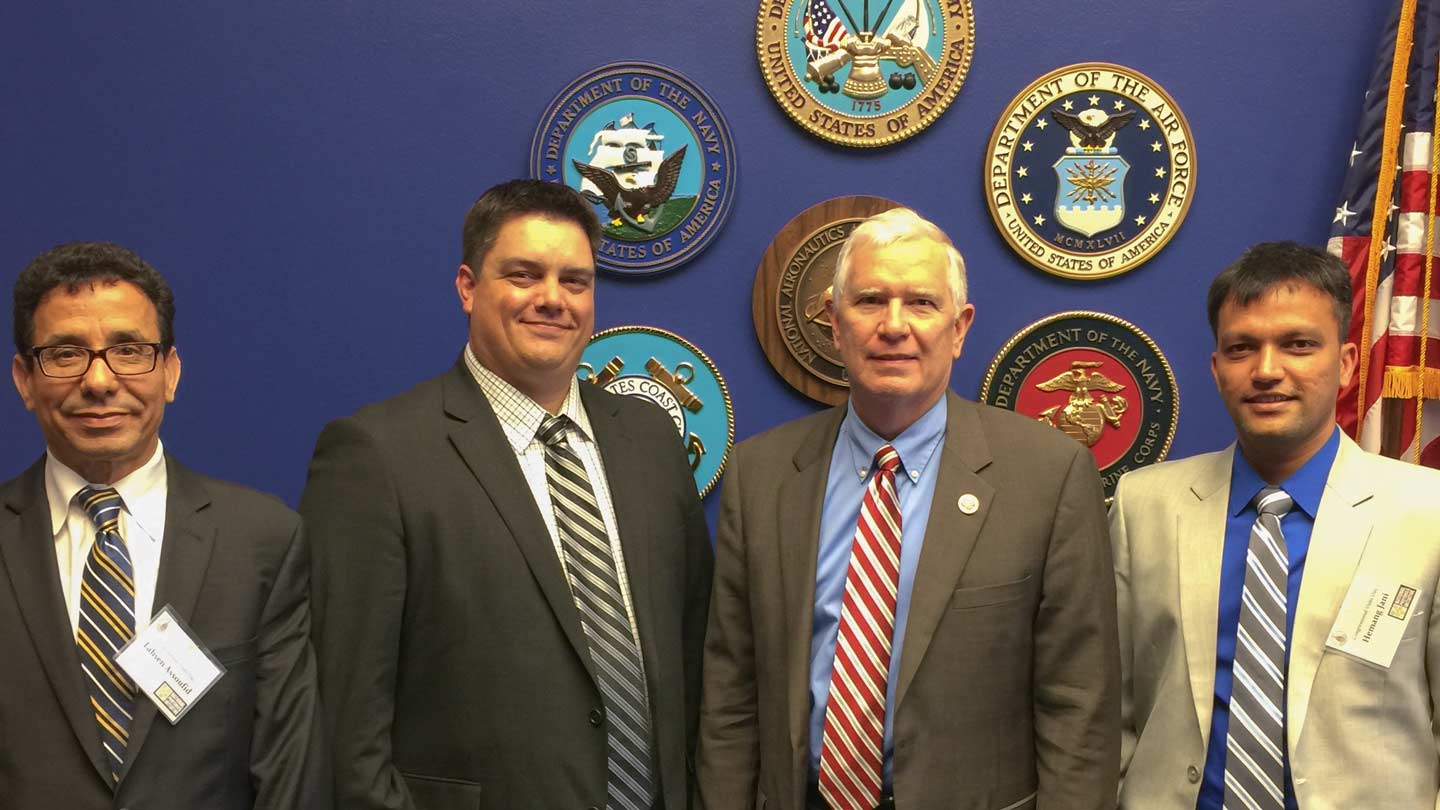
Meeting on Congressional Visits Day are, from left, Lahsen Assoufid of Illinois, team lead Joshua Miller from OSA, U.S. Rep. Mo Brooks and Hemang Jani.
Congressional photo
A doctoral student in photonics at The University of Alabama in Huntsville (UAH) was on a team that recently met with U.S. Rep. Mo Brooks of Alabama's 5th Congressional District and Congressional staffers in other offices in support of photonics and science research.
Hemang Jani, a doctoral student of Dr. Lingze Duan in Optical Science and Engineering in the Precision Ultrafast Light Sciences (PULS) group in the Department of Physics, was sponsored by the National Photonics Initiative (NPI) for the Congressional Visits Day (CVD) STEM on the Hill trip to Washington, D.C.
Optics and photonics are the science and application of light. Specifically, photonics generates, controls and detects particles of light to advance manufacturing, robotics, medical imaging, next-generation displays, defense technologies, biometric security, image processing, communications, astronomy and more.
"This is a unique opportunity to start building a relationship with Congressional offices and to inform them of the important optics and photonics work happening in their districts, while at the same time advocating for science. NPI has been doing this for the past couple of years," says Jani, who is from Vadodara, India, and has been at UAH since fall 2011 as an International Student.
In addition to Rep. Mo Brooks of Alabama's 5th Congressional District, Jani and the team met with staff members from the offices of Sen. Luther Strange of Alabama, Sen. Martin Heinrich of New Mexico, Sen. Tom Udall of New Mexico, Sen. Dick Durbin of Illinois, Sen. Tammy Duckworth of Illinois and Rep. Danny Davis of Illinois's 7th Congressional District.
"Some of the staffers of these Congressional offices may not have a science background," says Jani, whose research is in ultrafast nanophotonics. "So it is little challenging and exciting to translate our complex science into simple language in a way that we can connect with them. On the other hand, some of our appointments were with staffers having a Ph.D. in physics and chemistry. Events like CVD certainly teach you how to have an effective Congressional meeting."
He says he is encouraged by the support for science in the federal government.
"What I gather is that pursuing a career in public policy, for a scientist, is a good way to consolidate the presence of science, technology, engineering and mathematics (STEM) on the Hill," he says.
Jani was in Washington for two days, the first of which was spent in orientation and briefing sessions at the headquarters of The Optical Society (OSA). The day was capped with a reception in the Kennedy Senate Caucus Room in Russell Senate Office building at which the different science and engineering societies participating in CVD mingled. Congressional visits happened on the second day, with different groups from different states delivering NPI requests to Congress and its representatives.
NPI requests included supporting and making strong investments in science research and development funds, ensuring optics and photonics advances are included in existing and new infrastructure projects, and inclusion of optics and photonics technical training opportunities in legislation.
"To participate in CVD is a volunteer effort to help educate the members of Congress about photonics," Jani says. "Normally, there are a very limited number of student travel grants available that students can apply for."
To be eligible, the applicant must be a graduate student in the area of optics and photonics at an accredited university and be an OSA or SPIE member in good standing. Grants are provided based on responses to essay questions and geographic region.
"I really wanted to volunteer for this event, and based on my essay responses I was selected for the travel grant to attend this event," Jani says. "I would like to thank my adviser, Dr. Duan, for his discussions regarding talking points for CVD and his encouragement. I would also like to thank Dr. Tommy Cantey from Huntsville Electro-Optical Society (HEOS), who has been a past NPI CVD participant, for his useful tips and discussion for CVD."
NPI was formed by five organizations: The Optical Society (OSA); the International Society for Optics and Photonics (SPIE), the Institute of Electrical and Electronic Engineers (IEEE) Photonics Society (IPS), The Laser Institute of America and the American Physical Society (APS) Division of Laser Science.